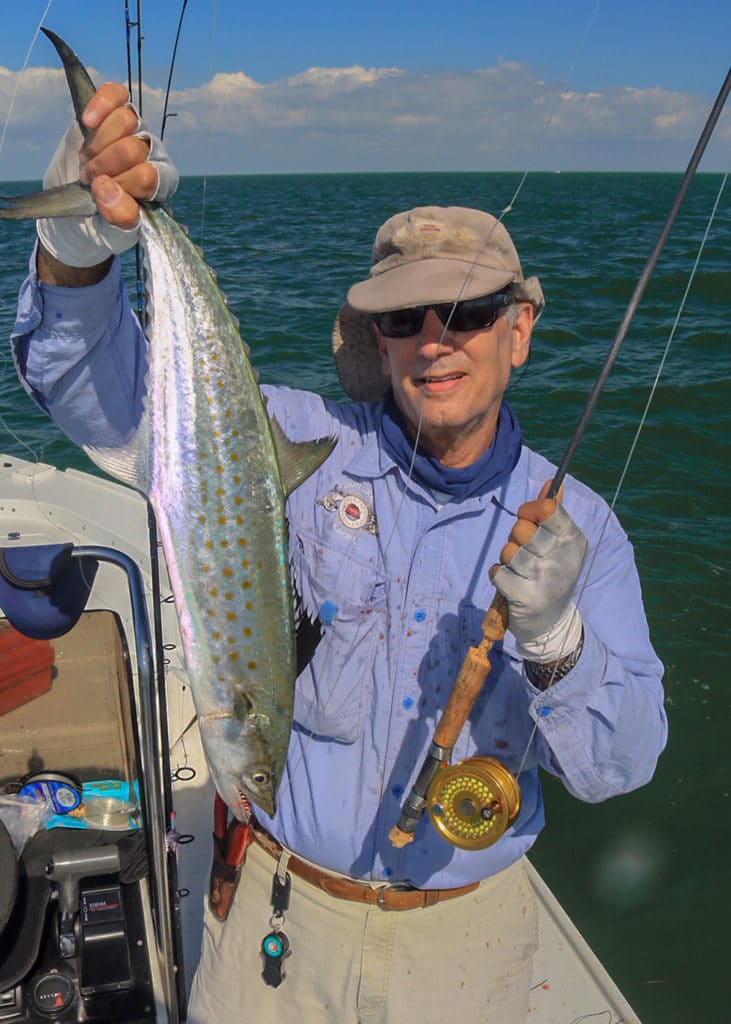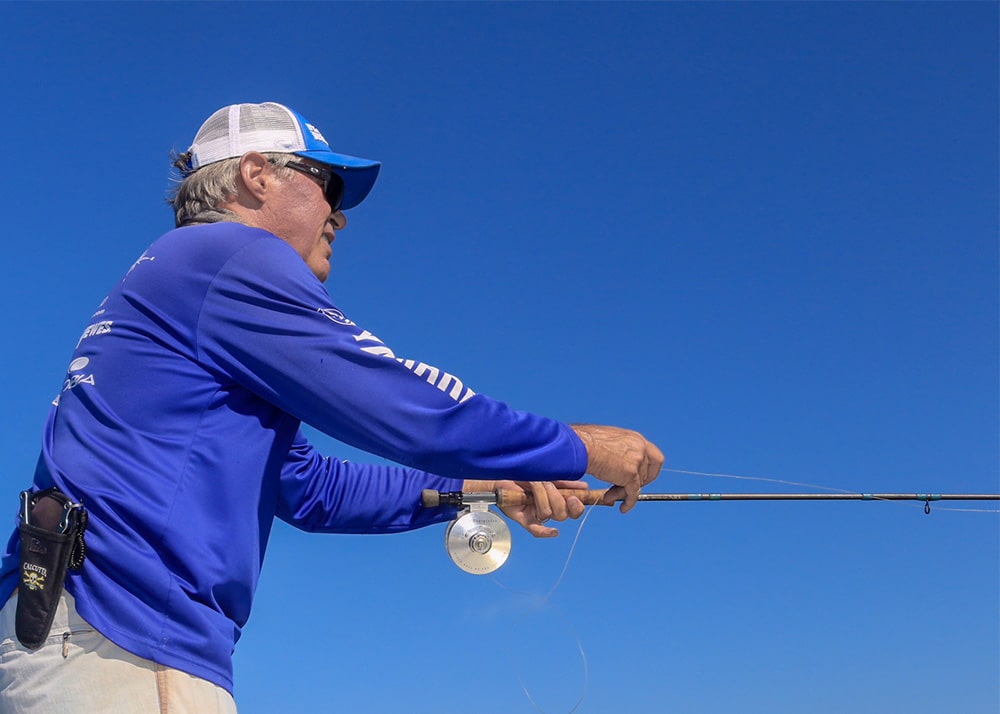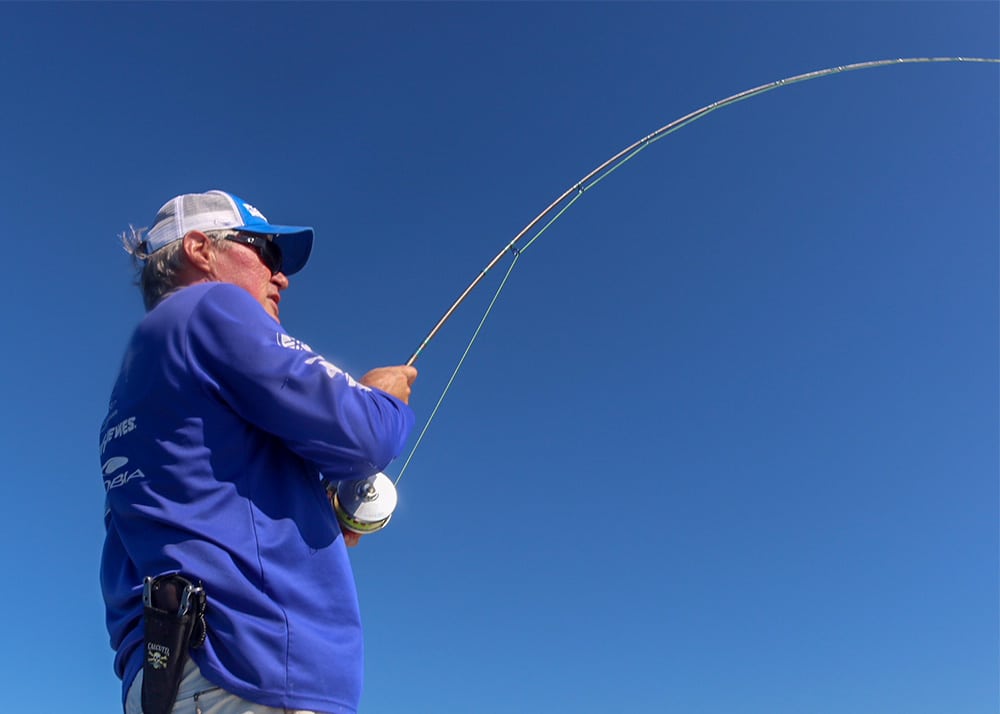
Catching fish on fly frequently requires you to cover some water, and drifting is a sensible way to do it. But unlike fishing with conventional gear and hardware, drift fishing with fly tackle calls for a bit more forethought and discipline to present your fly most effectively.
You are dealing with a moving boat, driven by wind and current, and with two or more fly fishers aboard, it takes coordination and extra care while casting. Traditional saltwater bait-fishing scenarios, such as fishing live shrimp under a popping cork while drifting, are deadly for finding spotted seatrout and redfish on a big grass flat, but fishing flies to arrive at the same result requires a different approach.
In the shallowest water, say three feet or less, you could cast a weighted fly, or a slow-sinking line, behind the drift of a boat as you would drag that shrimp and eke out a few fish, but it is far more effective to cast at a 45-degree angle ahead of the boat’s drift. That way you can give the fly a chance to sink close to the grass blades where fish lurk, and strip it properly. By the time the line and fly is behind the drift, it’s time to pick up and cast again.

Drift, Find, Stay
Once you find fish via drift-fishing you want to stay in them. Don’t assume that after a couple of hookups the fish are widespread and distributed. Some species school tightly, and it’s easy to lose track of where they are. Over years, and before electronics “marked the spot” and we had “electronic anchors” I planted my pushpole on grassflats upon getting seatrout action, and in slightly deeper soft grass bottom when fishing for mangrove snapper.

Now a Power-Pole or Minn Kota Talon can be deployed to stay on the fish, or the baitfish. I have gotten in the habit of using the Spot Lock feature of my electric motor to keep me on a spot where I’ve found fish on the drift, too. Of course, you could always toss an anchor, if you don’t have any of the above equipment. Once you do stop the boat, you can cast flies in any direction you desire, and fish a bit more thoroughly before resuming a drift.

Slow Your Drift
Drift socks (also called drift anchors and drogues) work like parachute, essentially a lightweight nylon bag that acts like a brake when deployed behind a drifting boat. They come in various sizes– 24-inch to 0ver 60-inch openings—and can effectively slow your drift. The largest models are for safety and are deployed in heavy seas to stabilize a vessel and keep its bow into the waves.

Skiffs and bay boats call for smaller models than do offshore boats. The drawback is that you have to deal with the main line and the trip line that collapses the anchor to make it easy to retrieve. But they work like charm.

I have a PowerPole Drift Paddle and it does what a drift anchor does, but unlike the drift anchor that can be tied off from any position in your boat (to change the boat’s angle to the drift) the Blade is attached to the main “spear” of the machine so you are restricted to drifting attitude, though the blade can be pivoted with seven position changes to basically “steer” your boat at angle as it drifts. So it’s a brake and a rudder. The advantage of this accessory over the traditional drift anchor is that you can raise the Power Pole more quickly than you manually retrieve the anchor once you hook a fish.

Cast and Fish
The optimum way to present your fly while drifting depends on a few conditions. First the wind, which is always the ruling factor when fly fishing. If wind, rather than tidal current, is what is pushing you along, use it to your advantage. You should cast downwind anyway, unless you are seeing surface feeding signs upwind. When blind-fishing (prospecting) I tend to make my casts long and at a 45-degree down-drift (ahead of the boat). That way, I can fish my fly deeper if desired and as I strip it back, I can keep the slack out of my line better than if I had cast straight ahead of the boat. You can also cast at a closer to 90-degree angle of your drift if using a surface popper or streamer that you want to fish just under the surface.
With two fly fishers aboard, you just have to coordinate the casting. Back cast crashed are common if you don’t. I always glance at my partner before making a line pickup to recast. Most of my fly-fishing friends are right-handed. I am left-handled which makes things easy, and keeps our lines outboard of the boat when in the air. A perfect scenario: Bow left, left-hander in the bow. Stern right, right-handed at the stern. Cast down-drift. Easy. When both casters are either right- or left-handed, one caster should deliver the fly with backhand casts. (You should strive to be proficient at backhand casting anyway for sight casting on the flats.)
If you have three to four anglers aboard who insist of fly fishing, take turns. Or, get a much bigger boat!

Chum on the Move
Though often thought of as a stationary fishing technique, chumming while drifting can shorten your search. And if there is no tidal current to speak of, and only wind, you can “paint” a nice chum trail behind your boat. I did this recently with a mesh bag full of crushed sand fleas and clam meat while drift-fishing pompano in the vicinity of a dozen other boats, and we bagged more fish than they did. Depending on the way your boat drifts with both current and wind at play, the chum might trail away from the boat at angles other than directly behind your drift. If you try this, cast into the chum trail as well as ahead of your drift. And if you hit fish, stop the boat and keep on chumming!

Lines and Leaders
When I drifting over grass flats in 3 to 6 feet of water for seatrout, pompano or mixed-bag action, I normally fish a slow-sinking clear intermediate, or at most a slightly denser full sinking line (such as a Scientific Angler Type 2 line) with a sink rate of at about 2 to 3 IPS (inches per second).

In deeper inshore or nearshore waters where I seek Spanish mackerel, small kings and little tunny, I fish this line if the fish are at the surface; otherwise I go to a slightly faster sink rate line.
With all sinking lines I opt for the shortest leader practicable. That keeps my fly at the level of the tip of the sinking line. You can get away with a 5- to 7-footer most of the time, especially with a clear-tip floating line or clear intermediate line. I was fishing this spring for pompano in a big basin just inside the St. Lucie Inlet near Stuart, and for every pompano I hooked, I hook four ladyfish. I lost a couple of flies to the raspy-jawed ladies, and had to cut back my leader when they frayed it badly. My leader ended up only two feet long, and I still hooked pomps! And of course, more ladies.

Fly Selection
A wide range of flies can be used, but when I drift-fish grassy flats in Florida waters, It is normally with baitfish or shrimp patterns. Or poppers such as the Gartside Gurgler when seatrout are super-aggressive or beefy bluefish raid the area. Bendbacks are terrific for the shallowest flats because they ride hook-up to decrease the chance of snagging grass, as does the Clouser Minnow, which may be the best pattern overall both on the deeper flats and along the beaches in mackerel or little tunny schools.

As a general rule, I would rather have the weight in my line than in my fly, for the sake of effortless casting. If stuck with a floating line, you have to use super heavy flies if the fish are near bottom in over 4 or 5 feet. A sinking line solves that. When I am on a pompano, mackerel or seatrout bite, the clear intermediate line matched with a lightly weighted Clouser or one of my specialty pompano flies (see photo) is a deadly combination that I cast with anywhere from a 7- to 9-weight rod.









